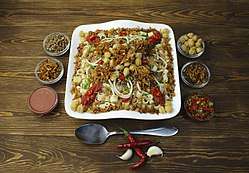Kushari
 Kushari | |||||||
| Type | Mixed-rice dish | ||||||
|---|---|---|---|---|---|---|---|
| Course | Main course | ||||||
| Place of origin | Egypt | ||||||
| Serving temperature | warm or hot | ||||||
| Main ingredients | rice, lentils, macaroni, tomato sauce, vegetable oil, onions, cumin | ||||||
| Variations | chickpeas, hot sauce, garlic juice, vinegar, short spaghetti | ||||||
| 954 kcal (3994 kJ) | |||||||
| |||||||
| Similar dishes | Khichdi | ||||||
Kushari, also koshari (Egyptian Arabic: كشرى, [ˈkoʃæɾi]), is an Egyptian dish originally made in the 19th century, made of rice, macaroni, and lentils mixed together, topped with a spiced tomato sauce, and garlic vinegar, and garnished with chickpeas and crispy fried onions. A sprinkling of garlic juice, or garlic vinegar, and hot sauce are optional.
History
Kushari originated in the mid 19th century, during a time when Egypt was a multi-cultural country in the middle of an economic boom. It was invented as a vegetarian food and it consists of Egyptian fried onions, lentils, rice, and macaroni. It is very similar to the Indian dish made from rice and lentils Khichdi, some believe it was transferred to Egypt through soldiers of the British army during the colonization of both countries. Over time the dish has evolved through Egyptian soldiers, then Egyptian citizens.[1] Kushari used to be sold on food carts in its early years, and was introduced to restaurants later.[2]
Kushari is widely popular among workers and laborers. It may be prepared at home, and is also served at roadside stalls and restaurants all over Egypt; some restaurants specialize in kushari to the exclusion of other dishes, while others feature it as one item among many.[3] As traditionally-prepared kushari does not contain any animal products, it can be considered vegan so long as all frying uses vegetable oil.
See also
References
- ↑ yahoo- maktoob CNBC
- ↑ Parvi, Shahrokh (6 March 2016). "Cheap, healthy and oh so tasty: the best kushari in Cairo". The Guardian.
- ↑ "Kushari recipe". Whats4eats.com. Retrieved 2013-02-17.
External links
| Wikibooks Cookbook has a recipe/module on |

- Egyptian Kushari with step by step photos from Food Lover
- Article on Egyptian vegetarian cooking
- A travel writer's take on Kushari in Cairo